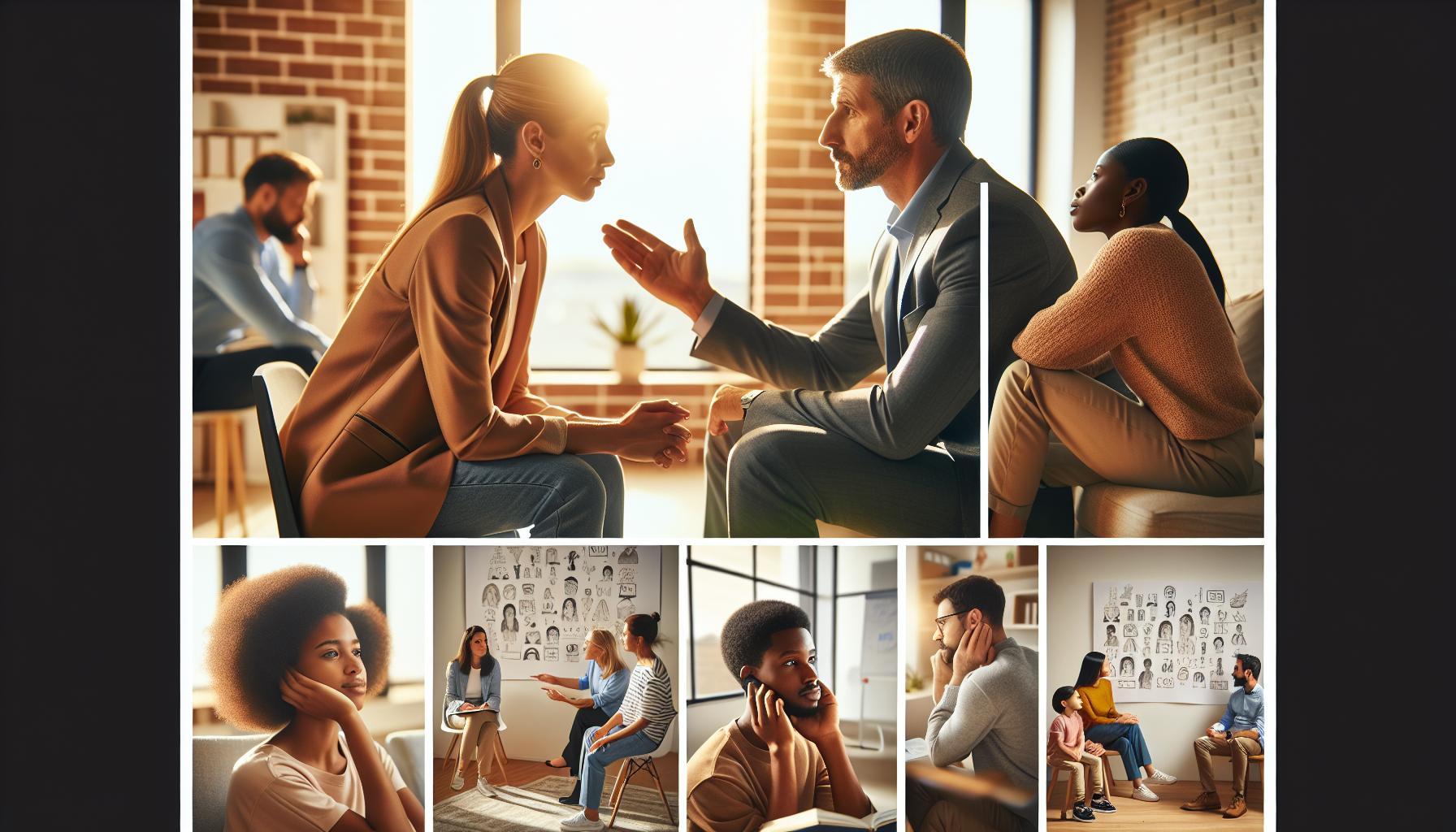Did you know that effective communication can dramatically improve counseling outcomes? Active listening is not just a skill-it’s the cornerstone of effective client conversations. By truly engaging with clients, counselors can foster trust and create a safe space for open dialogue, making clients feel heard and validated.
In today’s fast-paced world, many find it challenging to truly listen, but mastering this crucial skill can transform your practice. Imagine the impact on your client relationships when you learn to not only hear their words but also understand their emotions and perspectives deeply. This article will guide you through the essential techniques of active listening, equipping you with practical tools to enhance your counseling sessions. Get ready to unlock the potential of your conversations and enrich the lives of those you support.
Active Listening: The Foundation of Effective Counselling
Active listening serves as the cornerstone for effective counselling, fostering a supportive environment where clients feel valued and understood. The practice goes beyond merely hearing words; it requires a commitment to fully engage with the speaker, demonstrating empathy and validation of their feelings. By creating a safe space through active listening, a counsellor can facilitate deeper discussions, allowing clients to explore their thoughts and emotions without fear of judgement.
To effectively implement active listening, counsellors should focus on several key principles:
- Nonverbal Communication: Maintain eye contact, use appropriate body language, and nod to convey attentiveness.
- Reflective Listening: Paraphrase or summarize what the client has shared to confirm understanding and encourage further dialogue.
- Emotion Recognition: Acknowledge the client’s emotional state, validating their feelings and leading to a stronger therapeutic alliance.
- Avoid Interruptions: Allow the client to express their thoughts completely before responding, fostering a sense of respect and importance.
Incorporating these principles into counselling sessions paves the way for building trust and rapport. As clients feel heard and understood, they become more open to the therapeutic process, leading to transformative conversations. Additionally, active listening enhances the counsellor’s ability to assess the client’s needs, ultimately guiding the direction of therapy more effectively. Embracing these skills not only benefits client outcomes but also enriches the counsellor’s experience, leading to more meaningful interactions.
Understanding the Core Principles of Active Listening
Active listening is a fundamental skill that establishes a rich foundation for counselling, transforming mundane conversations into profound exchanges. To master this craft, one must engage deeply not only with clients’ words but also with their emotions and body language. The essence of active listening lies in creating an environment where clients feel safe and valued, allowing them to more openly share their thoughts and feelings.
Key Principles of Active Listening
- Nonverbal Communication: Body language plays a crucial role in active listening. Maintaining eye contact and using open body posture signal that you are fully present and engaged. Subtle gestures, such as nodding, can affirm that you are following the conversation, fostering a deeper connection.
- Reflective Listening: This technique involves paraphrasing or summarizing what you’ve heard to ensure clarity and show that you genuinely understand the client’s message. For instance, if a client expresses distress over a situation, you might say, “It sounds like you’re feeling overwhelmed by all the changes happening.” This reflection not only validates their feelings but also opens the door for further discussion.
- Emotion Recognition: It’s essential to recognize and acknowledge the emotional states of your clients. Validate their feelings by saying things like, “I can see this is really important to you,” which helps to reinforce their trust in you and solidifies the therapeutic alliance.
- Avoiding Interruptions: Let clients complete their thoughts without interjecting; this demonstrates respect and patience. It also ensures that they feel heard, which can be incredibly empowering for them during challenging times.
Incorporating these principles into your counselling sessions not only cultivates a rapport with clients but also enhances their willingness to engage in the therapeutic process. By consistently practicing active listening, you will be better equipped to assess their needs and tailor your approach effectively, leading to more impactful outcomes in therapy. Embrace these techniques as a pathway to not just improve your skills but to enrich the therapeutic journey for you and your clients alike.
Common Barriers to Active Listening and How to Overcome Them
Many practitioners struggle with active listening due to common barriers that can derail effective communication in counselling settings. One of the most prevalent obstacles is internal distractions, such as personal concerns or worries that occupy the mind. When practitioners are preoccupied, they may miss crucial cues from their clients. To overcome this, create a mental checklist before sessions to release personal distractions and fully commit to the conversation. For example, taking a moment to ground yourself through deep breathing can help shift your focus entirely to the client.
Another significant barrier is assumptions or preconceived notions about the client or their situation. These biases can lead to misinterpretation of the client’s message. Practitioners can combat this by adopting a mindset of curiosity, actively reminding themselves to suspend judgments and remain open-minded. Emphasizing the use of open-ended questions can also help uncover new insights and foster genuine understanding, rather than jumping to conclusions based on prior experiences.
Additionally, external distractions in the environment, such as noise or interruptions, can hinder effective listening. To mitigate this, set up a quiet, comfortable space for sessions to minimize external disruptions. For instance, ensuring phones are silenced and there are no visual distractions can lead to a more focused atmosphere. Finally, labeling these distractions and discussing them with the client can create a collaborative spirit in addressing the challenges of active listening together.
To strengthen active listening skills, encouraging reflective practices such as feedback sessions where practitioners can explore their listening experiences and challenges can also be beneficial. Engaging in regular self-assessment allows you to identify specific areas for improvement and adjust your approach accordingly. By tackling these barriers head-on, you will not only enhance your active listening abilities but also significantly enrich your counselling relationships.
Techniques to Enhance Your Active Listening Skills
Active listening is not just about hearing words; it involves fully engaging with the speaker and understanding their message on multiple levels. To cultivate this skill, practitioners can implement several techniques that enhance the listening experience, fostering deeper connections and improving overall communication.
- Maintain Eye Contact: This simple yet powerful technique signals to clients that their words are valued. It helps create a sense of safety and encourages open dialogue.
- Use Reflective Listening: Paraphrasing or summarizing the client’s statements affirms your understanding while allowing them to clarify their thoughts. For instance, saying “It sounds like you are feeling overwhelmed by work, is that correct?” demonstrates engagement.
- Incorporate Nonverbal Cues: Nodding, leaning slightly forward, and maintaining an open posture can all convey attentiveness. These subtle gestures provide additional reassurance to the speaker that their message is being received.
- Practice Empathic Responses: Validating the client’s feelings with phrases such as “I can see how that would be difficult for you” shows that you understand their emotions. This enhances the therapeutic alliance and encourages clients to share more deeply.
- Avoid Interrupting: While it’s essential to engage, resisting the urge to interject is crucial. Allowing clients to express themselves fully ensures that no key points are missed and fosters respect in the conversation.
Fostering these techniques requires ongoing practice. Incorporating role-play exercises in training sessions can be an effective way to rehearse active listening scenarios in a supportive environment. This may involve collaborating with peers to simulate client interactions, where each person alternates between the roles of listener and speaker. Utilizing feedback from these practice sessions can aid in identifying areas for improvement.
Incorporating reflective journaling after client sessions can also be beneficial. Practitioners should take time to reflect on their active listening experiences, pinpointing what worked well and what needed adjustment. This practice not only aids in skill development but also enhances self-awareness, helping professionals refine their approach continually. By actively engaging in these techniques, practitioners are empowered to transform their client interactions, paving the way for more effective and meaningful conversations.
Practical Exercises to Practice Active Listening in Sessions
To effectively cultivate active listening skills during counseling sessions, engaging in practical exercises can be a transformative experience. These exercises allow practitioners to develop empathy and understanding while creating a safe environment for clients to express themselves. One engaging approach involves role-playing scenarios where one practitioner assumes the role of the client while another practices their listening skills. This technique fosters real-time feedback and discussion, allowing participants to explore various emotional responses and listening strategies.
Another exercise that can enhance active listening is reflective journaling. After each session, practitioners can take a few moments to reflect on their listening experiences. They should write about what went well, what challenges they faced, and how they can improve in the future. This not only helps to solidify learning but also encourages deeper self-awareness, which is crucial in developing effective listening capabilities.
Integrating observational exercises within training groups can also be beneficial. Participants can observe each other’s counseling sessions and take notes on the various active listening techniques used. Afterward, they can engage in a discussion to provide constructive feedback and share insights on the effectiveness of different methods. This peer review process can be incredibly enlightening, revealing common barriers to active listening and ways to overcome them, while also inspiring confidence in each other’s growth.
Additionally, consider implementing “listening circles” where practitioners come together to share personal challenges and experiences in a structured format. Each participant takes turns sharing, while the others practice active listening without interruptions. Participants can then provide feedback on what listening techniques were effective, further enhancing their collective understanding of how to create supportive environments for clients. By incorporating such exercises regularly, practitioners can gradually refine their active listening skills, transforming their client conversations into richer, more meaningful dialogues.
Transforming Client Relationships Through Active Listening
In the realm of counseling, active listening stands as a pivotal element that can profoundly transform client relationships. When practitioners fully engage with clients by demonstrating genuine interest and understanding, they create an environment where clients feel valued and heard. This sense of validation fosters trust, reducing barriers that may inhibit open communication. As clients sense their emotions and thoughts are respected, they’re more likely to disclose deeper feelings, facilitating a more productive dialogue.
Moreover, active listening enhances a counselor’s ability to address issues effectively. By focusing not only on the words spoken but also on non-verbal cues such as body language and tone, counselors can gain deeper insights into clients’ emotional states. This comprehensive understanding allows practitioners to reflect back what they perceive, providing clients the opportunity to clarify or explore their feelings further. For instance, a counselor might say, “It seems like you’re feeling overwhelmed by this situation; can you tell me more about that?” Such affirmations demonstrate that the counselor is attuned to the client’s experience, reinforcing rapport.
To cultivate these relationships more deeply, counselors can employ specific techniques. Utilizing open-ended questions invites clients to express themselves without the constraint of yes or no answers, promoting richer dialogue. For example, asking “What has been the most challenging aspect for you recently?” encourages exploration of complex emotions. Follow-up questions can elaborate on initial thoughts and guide discussions toward resolution and insight.
In practice, these interactions lead to profound changes not only in the client’s perspective but also in the counselor’s approach. As practitioners hone their active listening skills, they transform their own experiences within the counseling relationship, moving from mere facilitators to empathetic partners in the client’s journey. This collaborative engagement ultimately results in more meaningful exchanges, fostering an environment ripe for healing and personal growth.
The Role of Empathy in Active Listening
Empathy serves as the heartbeat of active listening, transforming a basic exchange of words into a profound connection. When a counselor actively listens with empathy, they acknowledge not only the content of what the client is saying but also the emotions beneath the surface. This understanding creates a safe space for clients, encouraging them to express their innermost feelings without fear of judgment. Empathetic listening involves not just hearing but deeply comprehending the experiences and perspectives of others, which is essential in a counseling context where clients often grapple with vulnerability.
To cultivate empathy during active listening, counselors can employ several effective strategies. Firstly, practicing mindfulness can enhance awareness of personal emotional responses, allowing counselors to distinguish their feelings from those of their clients. This self-awareness is crucial when interpreting a client’s emotional landscape. Encouraging clients to articulate their emotions explicitly can also facilitate this process. For example, a counselor might say, “I notice you’re expressing a lot of frustration; can you tell me more about that?” This approach not only validates feelings but encourages deeper exploration.
Moreover, using reflective listening can significantly deepen the empathetic connection. This involves paraphrasing or summarizing what the client has shared to demonstrate understanding. Statements like, “It sounds like you’re feeling unheard and overwhelmed,” can offer clients clarity and reinforce that their feelings are acknowledged. This technique encourages clients to expand on their thoughts, fostering richer dialogue and deeper self-exploration.
Incorporating non-verbal cues, such as maintaining eye contact and using appropriate facial expressions, further supports empathetic listening. These gestures signal to clients that their feelings are being valued and understood, strengthening the therapeutic alliance. Counselors who actively engage in these practices not only improve their relationships with clients but also empower them on their healing journeys by creating a validating and affirming space for engagement.
Using Open-Ended Questions to Foster Client Engagement
Engaging clients effectively often hinges on the questions we ask. Utilizing open-ended questions is a powerful technique that can transform the dynamics of a counseling session. Unlike closed questions, which typically yield a simple “yes” or “no” response, open-ended questions encourage clients to elaborate on their thoughts and feelings, fostering deeper dialogue and reflection. For instance, instead of asking “Did you feel upset during your last session?” a more impactful approach might be, “Can you describe how you felt after our last session?”
These types of questions not only facilitate expanded conversations but also promote a sense of freedom for clients to express themselves fully. This technique is particularly valuable in establishing rapport and trust, creating a safe environment where clients feel their experiences are valued. Counselors can employ several strategies to frame open-ended questions effectively:
- Encourage Exploration: Questions like “What are your thoughts on that?” invite clients to delve into their feelings.
- Seek Insight: Asking “How did that situation affect you?” helps clients connect actions to emotions.
- Engage in Problem-Solving: Phrasing questions such as “What options do you see for moving forward?” empowers clients to explore solutions.
In practice, incorporating open-ended questions can shift the counseling session from a passive conversation to an interactive exploration. This not only enriches the client’s experience but also allows counselors to gather essential insights into their clients’ emotional landscapes, leading to more tailored and effective guidance. By consistently practicing this approach, counselors can cultivate their skills and enhance overall client engagement, making significant strides in their therapeutic relationships.
Active Listening in Crisis Situations: Strategies and Tips
In times of crisis, the stakes are incredibly high, and effective communication becomes crucial. Active listening can serve as a lifeline, allowing clients to feel heard and validated during their most challenging moments. By fully engaging in the conversation, counselors can demonstrate genuine concern and facilitate a safe space where clients can express their emotions without fear of judgment.
To effectively apply active listening during a crisis, counselors should adopt specific strategies. Begin by ensuring a calm and composed demeanor, which can instill a sense of stability for the client. Maintain eye contact and use nonverbal cues, such as nodding, to show attentiveness. Additionally, avoid interrupting; let the client articulate their thoughts and feelings completely. As they share, use reflective techniques to summarize and paraphrase their statements. For example, you might say, “It sounds like you’re feeling overwhelmed about the situation” to confirm your understanding and encourage further exploration.
In crisis scenarios, employing open-ended questions can also be highly effective. Encourage clients to delve deeper into their feelings by asking questions like, “What has been the most challenging aspect for you recently?” This approach not only helps gather more information but also empowers clients to examine their emotions critically. Furthermore, integrating empathy into your responses can foster a stronger therapeutic alliance. Phrases such as, “I can see how that would be really difficult for you” signal to the client that their feelings are understood and acknowledged.
Lastly, always be prepared to adjust your listening approach as the conversation unfolds. If a client appears particularly distressed, prioritize emotional validation over problem-solving. Reassure them that it’s okay to feel what they are feeling, allowing them to process their experiences fully. With consistent practice of these techniques, counselors can enhance their active listening skills, transforming client interactions into transformative experiences even during crises.
Measuring the Impact of Active Listening in Counselling
In the realm of counseling, the ability to measure the impact of active listening is crucial for both client progress and therapeutic outcomes. When practitioners actively engage in listening, the results can manifest in various tangible and intangible ways. For instance, clients often report feeling more understood and valued, which can lead to increased trust in the therapeutic relationship. This enhanced rapport not only encourages open dialogue but also fosters a safer environment where clients are more likely to share deeper emotions and concerns.
To effectively gauge the impact of active listening, consider employing a mix of qualitative and quantitative assessment methods. Utilizing client feedback through structured questionnaires post-session can provide insight into how well clients feel heard. Furthermore, reflective practice can serve as a valuable tool: by regularly reviewing session recordings or notes, counselors can critically analyze their own listening habits and identify areas for improvement. For example, tracking specific metrics, such as the frequency of reflective responses or the use of open-ended questions, can help quantify changes in engagement levels during sessions.
In addition to self-assessment, peer reviews can enhance understanding of active listening’s effectiveness. Engaging in supervision or consultation with colleagues allows for broader perspectives on listening practices. Counselors can exchange feedback and analyze client interactions, enabling them to recognize successful techniques they may want to adopt or adapt. Group discussions can also uncover common barriers and solutions, promoting a collective improvement in counseling practices.
Finally, it’s essential to recognize the anecdotal evidence stemming from successful client outcomes as a measure of active listening’s impact. Tracking client progress over time-such as improvements in self-reported emotional regulation or symptom reduction-can directly correlate with enhanced listening skills. Integrating regular evaluation of these outcomes creates a cyclical improvement model, where feedback informs practice, leading to better client experiences and outcomes, and ultimately fostering a culture of continuous professional development.
Continuous Improvement: Developing Active Listening Skills Over Time
Active listening is not merely a skill but an evolving practice that requires consistent effort and self-reflection. Taking small but crucial steps to enhance your listening abilities can lead to profound improvements in your counseling sessions. One effective way to start is by setting specific goals for yourself. For example, you might aim to incorporate one new active listening technique each week, such as summarizing what a client has said or using nonverbal cues to show engagement. By focusing on concrete objectives, you can gradually build a repertoire of strategies that enhance client interactions.
Another vital aspect of continuous improvement is being open to feedback. Create a system where clients feel comfortable providing insights into their experience during therapy. Consider implementing brief feedback forms at the end of sessions to gather their perspectives on your listening practices. This method not only allows you to identify areas for growth but also strengthens the therapeutic alliance, as clients see that you value their input. Additionally, discussing your performance with a trusted colleague or mentor can provide fresh insights and highlight blind spots in your approach.
Engaging in regular self-reflection is equally important. After each session, take a moment to jot down notes about what went well and what could be improved regarding your listening skills. This practice aids in recognizing patterns in your behavior and the emotional responses of your clients. You could also record sessions (with client consent) to review later, analyzing your use of techniques like reflective responses and open-ended questions. This type of evaluation can reveal how effectively you’re listening and whether your nonverbal communication aligns with your verbal messages.
Incorporate ongoing professional development opportunities such as workshops, webinars, or reading current literature on active listening. Attend seminars that focus on new strategies and research findings, as staying updated on best practices can inspire new techniques. Combining theoretical knowledge with practical application allows for a deeper understanding of clients’ needs and reinforces the importance of active listening, ultimately fostering a more supportive and effective counseling environment.
FAQ
Q: What are common mistakes in active listening during counselling?
A: Common mistakes in active listening include interrupting the client, making assumptions, and providing premature solutions. To improve, focus on maintaining eye contact, reflecting emotions, and allowing the client to express themselves fully before responding. Practicing patience enhances the therapeutic relationship [2[2].
Q: How can active listening help with client resistance in counselling?
A: Active listening can reduce client resistance by validating their feelings and fostering trust. When clients feel heard and understood, they are more likely to open up. Techniques such as empathetic reflections and open-ended questions can help facilitate more cooperative conversations [3[3].
Q: How does body language affect active listening in counselling?
A: Body language significantly affects active listening as non-verbal cues can communicate empathy and engagement. Maintaining an open posture, nodding, and using facial expressions to reflect understanding can enhance the connection and encourage the client to share more openly [2[2].
Q: What role does summarizing play in active listening?
A: Summarizing is crucial in active listening as it confirms understanding and allows the client to clarify or expand on their thoughts. By paraphrasing key points, the counsellor demonstrates attentiveness and helps the client feel validated, thus deepening the conversation [1[1].
Q: When should a counsellor use silence in active listening?
A: Silence can be a powerful tool in active listening, allowing clients to process their thoughts and feelings. Counsellors should embrace silence after asking a question or when a client seems reflective, providing them space to articulate their insights without interruption [2[2].
Q: How do open-ended questions enhance active listening in counselling?
A: Open-ended questions stimulate deeper conversation and provide clients the opportunity to express themselves fully. They encourage exploration of feelings, thoughts, and experiences, making clients feel valued and understood. Incorporate these questions regularly to foster engagement and insight during sessions [1[1].
Q: Why is empathy important in active listening for counselling?
A: Empathy is vital in active listening as it builds trust and rapport between the counsellor and client. By demonstrating empathetic understanding, clients feel safer to share vulnerable emotions, leading to a more effective and supportive counselling experience [3[3].
Engage further with the techniques discussed to transform your conversations and strengthen your counselling skills today!
Key Takeaways
Empower your counselling practice today by mastering active listening skills that can transform your client conversations. Remember, as you cultivate these essential techniques, you’re not just enhancing your professional toolkit; you’re also deepening the trust and rapport with your clients. Don’t wait to implement these strategies-start practicing them in your next session and witness the profound changes they can bring.
For further exploration, dive into our related resources on effective communication strategies and the role of empathy in counselling. Consider signing up for our newsletter to stay informed about new techniques and insights that will elevate your practice. If you’re ready to enhance your skills, check out our comprehensive training modules designed to foster real-world application. Together, let’s ensure every conversation counts!
Share your thoughts or experiences in the comments below; we’d love to hear how active listening has impacted your work. Your journey to becoming a more effective listener starts now-take the first step and engage with these resources today!





